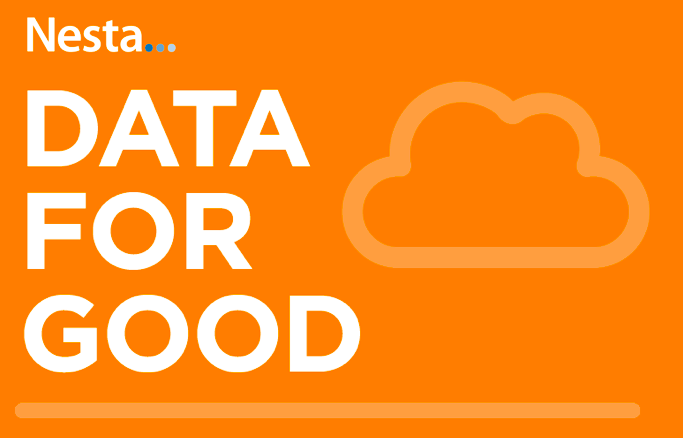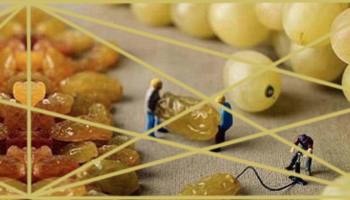
One of our guests at the recent Goteathon was Maria Botella, who is the main researcher in the European Alternatives project “Mapping BTR”, a Nesta Policy and Research grant awardee for “Data Driven Methods for Mapping Below the Radar Activity in the Social Economy”. According to their website, “Mapping BTR” is a research project exploring how data-driven methods can be deployed to automatically identify “Below the Radar” organizations in crowdfunding platforms, in this specific study, UK-based.
“Below the Radar” (BTR) is a term presently being used to describe those organizations which have a social purpose supported by voluntary activity, but which are not affiliated, registered or regulated, and (perhaps therefore) have no apparent, direct financial support from traditional funding entities. These are considered third sector organizations, and are understood to be voluntary and non-profit in nature. The significant implication in the label BTR is that by being below the radar, or undetected, this type of organization has a tendency to operate in more tenuous and less sustainable ways. For this reason, BTRs often gravitate toward crowdfunding as a means to gain financial and community support.
The Mapping BTR study documented a methodology developed for mapping BTR activity, focused on two UK-based crowdfunding platforms. In selecting these platforms, the study authors used the following questions as criteria:
- Which platforms are likely to be used by UK-based BTR groups to connect with their target audiences?
- Which platforms had sufficient data on groups that can be considered BTR organisations?
- Which platforms presented a suitable data structure to allow deployment of the co-link analysis, the method selected to map BTR activity?
The two platforms chosen were Spacehive and Crowdfunder, each with some unique characteristics that fit the study’s criteria and yet different enough from one another to provide some contrast. Spacehive keeps its focus narrowed down to projects with a social, civic purpose, and describes itself as “...a crowdfunding platform with a purpose: to make it as easy as possible for as many people as possible to bring their civic environment to life.” On the other hand, Crowdfunder’s aim is more broadly towards development in general: “Crowdfunder Mission: Connecting entrepreneurs with investors around the world to help fund their business and fuel economic growth.”
The authors of the study developed a methodology for identifying and tracking BTRs through their presence and activities on crowdfunding platforms, including a web-crawling software prototype developed to track activity, using hyperlinks. The process is called “co-link analysis”, employed to identify common themes, connected via hyperlinks, in crowdfunding campaigns. In earlier, unrelated uses, the process was used to uncover what was called “issue networks”, or groups of websites with common themes, connected by hyperlinks. Adaptations were made to the method for this study, due to the data structures in each crowdfunding platform. Typically, crowdfunding projects don’t link to one another, but instead link back to the profiles of their own backers - and in turn, to the other projects (if any) that those backers have supported.
Links from the first crowdfunding projects identified (which the study termed “seed projects”) were analyzed to identify additional, potentially similar projects. Only projects with at least 2 contributors in common with the “seed” are analyzed. Similarly, the projects tracked from the original “seed” are also expected to have a similar theme in common, e.g., environmental concerns. The following additional criteria were put in place:
- Only successfully funded projects (for the potential longevity)
- Only BTR organizations (for the aims of the study)
According to the authors, the criteria for determining which projects were probably run by BTR organizations is:
- They meet the condition upon which co-link analysis is based
- They have reached their funding target
- They are not run by registered organizations
The publication resulting from the research is a report called Data for Good, a compilation of reports generated by five projects released as a PDF by Nesta. Also available for download is a working paper for this project. The purpose of these publications is to explore how big and open data may be used for the common good, either by charitable organizations in their strategic development and refinement, and as a resource for the education of civil society.

We asked main researcher Maria Botella the following questions about the experience of conducting the study - the process, the results, and about the use of open API and data. Here we present her answers:
Regarding the choice to map BTR (below-the-radar) organizations and projects that operate under them, what is the ultimate purpose of this mapping? Specifically, is there some advantage in identifying projects and organizations operating in this unregistered, unaffiliated way, which benefits or helps support the sustainability of these projects or organizations? How might any political influence be achieved through identifying the BTRs?
The research project ‘Mapping BTR organisation on crowdfunding platforms’ is one of the five projects that were awarded the grand ‘Data Driven Methods for Mapping Below the Radar Activity in the Social Economy’, by the Nesta Policy and Research Unit. This grant programme builds upon existing voluntary sector research in the UK, more specifically, the work of the Third Sector Research Centre (TSRC) on its research stream ‘Below the radar’.
This research work runs parallel and operates within the specific political context of the UK. Over the last five years, regulation has been set up under the Conservative Party mandate that seeks to implement the ‘Big Society’, which is intended to ‘give citizens, communities and local government the power and information they need to come together, solve the problems they face and build the Britain they want’i. This contested concept is seen by many as the neoliberal ‘solution’ to the large-scale cuts in public expenditure, as an integral part of the goal of reducing the size of the state.
There is an urge to identify who those ‘communities’ - which can potentially benefit from being part of the Big Society by receiving support by the public and the voluntary sector and getting involved in decision-making in their local area - are. Otherwise, those resources risk remaining underused and the needs and claims of these communities unfulfilled, as they might just do not know the channels to become part of the Big Society and to count as such.
It is in such context that BTR research takes on its full meaning. However, the extent to which the results of BTR research are noted and acted upon by public and voluntary organisations remains a mystery for me.
Were the identified BTR projects informed that they were being included in this study? If so, were there any notable reactions to this information?
Actually they were not. The results of the case studies were only sent to the two crowdfunding platforms concerned.
Do the relationships uncovered by the co-link analysis you are using result in information about relationships that go beyond the thematic? If so, what other kinds of links or relationships has your co-link analysis uncovered?
Fundamentally not. Co-link analysis is used here to identify thematically related projects based on their common backers. Yet, to understand what exactly those thematic relations consist of, further analysis of projects and organisations has to be undertaken.
In doing so, a different type of relation among the Crowdfunder projects found was uncovered: a number of well-connected projects on the Crowdfunder network visualisation were part of the same campaign on the platform, the Crowdfund Cornwall Campaign, aimed specifically at funding Cornish projects. This geographical relation among Crowdfunder projects could be read as a success of the platform campaign in getting backers to support different projects in a given area.
Why might it be interesting or useful to your organization to have available API data for crowdfunding in Europe to create an expanded mapping? What ultimate purpose might that mapping serve?
Having available an API to collect data on BTR organisation in crowdfunding platforms across Europe would allow European Alternatives to furthering BTR research beyond the UK – something it has already done to some extent with qualitative methods through projects such as ‘Transeuropa Caravans’- but also to do some type of intervention based on the resulting mapping.
I can imagine, for instance, using those data to map initiatives searching for funding to accomplish similar or complementary projects, and this way, to identify distinctive themes across BTR initiatives in Europe. This analysis could serve to inform and push forward policies to support such initiatives at a national and European levels and / or to forge strategic partnerships between them.
What information might be visualized and utilized about the backers (donors) of the “seed” projects discovered in the co-link analysis? What ultimate purpose might that information serve?
The network visualisation could be extended to include backers and project creators as a second and third type of nodes. When clicking on one of these nodes, the right-hand panel would show all the other projects backed or created by that user and a measure of his overall activity on the platform.
This information could be employed by crowdfunding platforms to evaluate whether it would be worth it to include a similar type of analysis in future platform developments, such as a recommendation system that could offer creators and backers whose rate of activity is above a given threshold other projects they would likely want to support, based on the projects they have already created / backed. This is something that Change.org does with its sponsored petitions, which constitutes one of its main sources of funding.
Since Facebook wasn’t a cooperative participant in terms of open API, has any other social media platform been considered or approached for collaboration on this kind of analysis and mapping?
No, only the two crowdfunding platforms involved in this project were approached and asked for consent.
Was it possible to draw any visualizations, comparisons or conclusions between the social returns offered by BTRs as compared with those from projects with affiliations to supporting organizations?
No. In fact, it is not rare to find BTR projects and projects run by voluntary organisations or social enterprises on these crowdfunding platforms that present similar goals. Moreover, one of the main conclusions drawn from the two case studies is that BTR activity on crowdfunding platforms appears often combined with that of registered organisations and governmental bodies, making it difficult to analyse BTR activity as a pure and isolated entity.
Was there any specific information you wanted to find in the API of the two UK crowdfunding platforms, but did not have access to?
Yes, the information needed to perform co-link analysis. That is to say, the backers for each project. This would allow to identify new projects that share at least two backers with the seed project in a way far more consistent than using web crawling techniques. These new projects are expected to have a purpose similar to that of the seed – a social one in this case.
An easier way to identify social-oriented projects would be to define a specific category for this type of project while allowing creators to tag their projects with more than one category, thus making sure that no project with a social purpose is missed for having been classified under a different category.
The two crowdfunding platforms used in this research present such a category – and indeed project categories are available at least through the Crowdfunder API, but they do not allow creators to use more than one category at a time, what reduces significantly the amount of projects with a social purpose that can be achieved in this way.
Furthermore, being able to access the names of the organisations behind projects through an API would also have been extremely useful for this research.
What specific use could you make of the Goteo API in your research?
In order to deploy the methodology employed in my research using the Goteo API, the API would have to be extended to include ‘projects’ as an endpoint. Different ways of collecting BTR projects could then be implemented based on the features enabled for this endpoint. So, for instance, having the ID of donors among the response values would allow to deploy co-link analysis, while being able to filter projects by categories would enable an alternative way to check for the purpose of projects as described above.
Moreover, including the name of the organisation behind every project – it being either a formal or informal organisation or an individual - among the response values would allow to check whether that name is included in the official registers containing voluntary organisations and alike in order to remove projects created by registered organisations from the results. However, getting the creator of a project to specify whether the project belongs to a registered organisation or to a community group / informal organisation would make this analysis much more straightforward.
I see a great potential in combining the collection of data with the suggested endpoint and the ‘categories’ endpoint for future BTR research. In line with the mapping of BTR projects across Europe mentioned above, the BTR projects returned by the projects endpoint could be used as parameters of the ‘projects’ filter for the categories endpoint. Using that filter together with three other filters available for this endpoint, ‘location’, ‘from_date’ and ‘to_date’, would enable to collect suitable data to inform some maps visualisation showing the evolution of BTR project themes in different geographical areas over time.
What kinds of apps can you imagine being created from the Goteo API?
A recommendation app to show users the projects they could support based on their interests – determined by the other projects they have already funded or collaborated in. Unlike the recommendation system mentioned before, this would not be implemented by the platform. Rather, it would be an external piece of software that users would have to intentionally download and use.
What other potential uses do you see for the Goteo API?
I imagine the data available through the different ‘reports’ endpoints being matched up, analysed and explore by Goteo and other crowdfunding platforms in order to get an insight into how to improve the performance of crowdfunding projects and the platforms in themselves.
The Goteo statistics visualisations can well serve such purpose, in the same way that the Civic Dashboard created by the Citizens Advice Bureau (CAB) and Data Kind was intended to ‘give Citizens Advice staff an immediate overview of how issues are changing across the UK, visualise and analyse social and economic trends and use this to inform and shape the public debate and strengthen the impact of service delivery’.
Moreover, project creators can also use those data to understand what makes a successful project and social entrepreneurs to search for inspiration and new businesses opportunities.
As this research project shows, BTR organizations are an untapped resource when they are not yet identified and brought into a position to influence political change- and policy-makers. One of the Goteo community's multi-project promotors that began as a BTR is Civio, who describe themselves as “a civil society organization that fights for a better democracy”. After 4 successful Goteo crowfunding campaigns (including Spain in Flames, Quién Cobra la Obra, Who's in Charge?, and Your Right to Know), Civio has made the journey from a BTR to a registered foundation and opinion maker. More research about and outreach to BTRs could extend opportunities to similar initiatives, and in turn help to develop more solidarity and community.
We thank Maria Botella for her participation in our Goteathon, and look forward to more of her research, and opportunities for collaboration.





 Joan B. Cabot
Joan B. Cabot 

 Manuela Frudà
Manuela Frudà